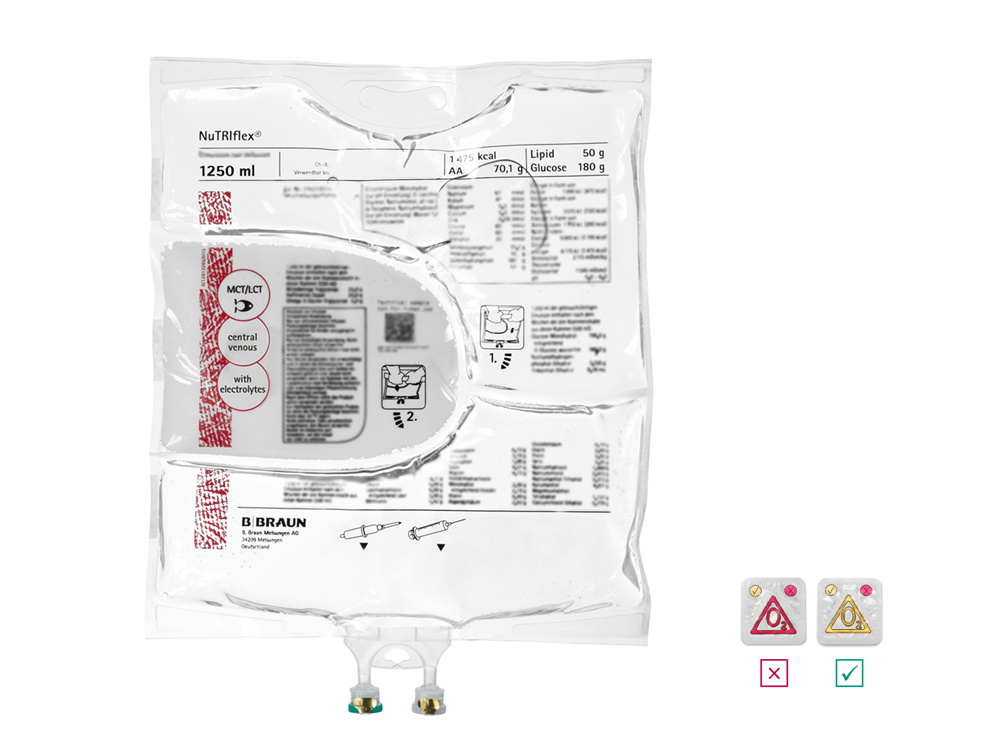No content results match your keyword.
Content
You have successfully logged out.
Not registered yet?
Multi-Chamber Bag Compounding
Multi-chamber bags assist pharmacists in the safe drug compounding of total parenteral nutrition (TPN) solutions.
B. Braun offers a wide range of ready-to-use 3-chamber bags named Nutriflex® Lipid and Nutriflex® Omega*. Our bags with and without omega-3 fatty acids are easy to compound by design. Discover all benefits for pharmacists.
*Names vary from country to country
This website is an international information resource intended only for Healthcare Professionals.
Confirm Yes, I am a health care professional. Cancel No, I am not a health care professional.

Type of lipid emulsion in
/
Tamper evident ports with a sterile surface enhance the sense of security. Color coding: Different port colors clearly differentiate between the additive (white cap) and the infusion port (green cap).
/
Do not use the bag if the oxygen indicator is pink. Use the bag only if the oxygen indicator is yellow.1-4, 23-26
/

1| Medium Chain Triglycerides: Source of readily available energy
2| Soya Bean Oil: Covers essential fatty acid requirements
3| Omega-3-acid Triglycerides: From fish oil for the delivery of EPA and DHA

with Lipofundin® (MCT/LCT) as lipid component.1-4 Licensed for use in children older than 2 years old, adolescents and adults.Lipofundin® Medium-chain triglycerides / long-chain triglycerides (MCT/LCT) can be liver-protective5-10, improve lung function11-21 and may reduce morbidity and mortality.22

(MCT/LCT/Omega-3-acid Triglycerides) as lipi component.4, 23-26 For the use in adults. Lipidem® / Lipoplus® can reduce the risks of nosocomial infections27, reduce hospital length of stay29-30 and may improve O2 gas exchange.28
with Lipofundin® (MCT/LCT) as lipid component.1-4 Licensed for use in children older than 2 years old, adolescents and adults.Lipofundin® Medium-chain triglycerides / long-chain triglycerides (MCT/LCT) can be liver-protective5-10, improve lung function11-21 and may reduce morbidity and mortality.22
With our compatibility software EasyComp you can check compatibility and stability of a regimen before you prepare the mixture. EasyComp allows corrective measures if compatibility is not confirmed.

Nutriflex®
Multi-chamber bags for parenteral nutrition are used as synonym for standardized, commercially available ready to use products with two or three chambers.
Get more product information
ESPEN Guideline Summary
Clinical nutrition in the intensive care unit – Focus on parenteral nutrition
link
ESPEN Guideline Oncology Summary
ESPEN practical guideline: Clinical Nutrition in cancer
link
Nutrition Screening acc. to NRS 2002
Assessment of the nutrition state
link
Subjective Global Assessment (SGA)
Assessment of the nutrition state
link
Nutriflex® 3-Chamber Bags for Parenteral Nutrition
Bag evolution and extended portfolio
link